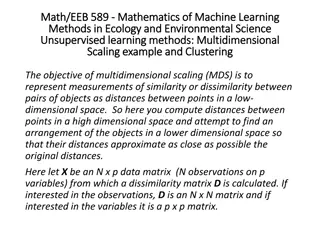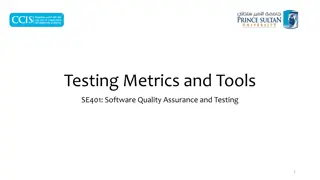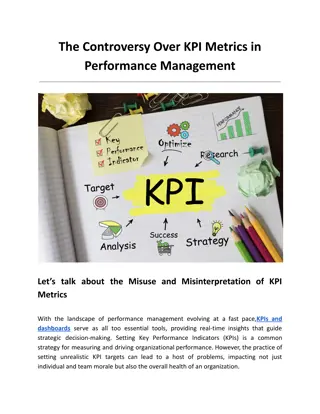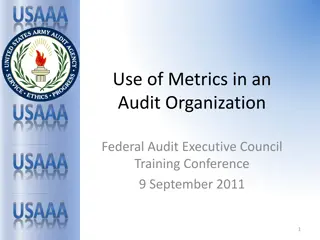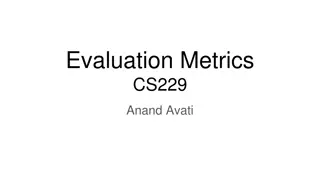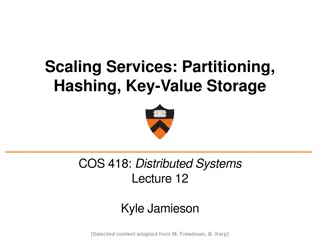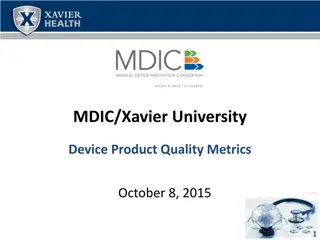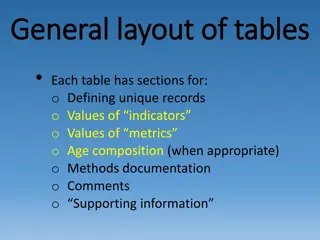Scaling Graphite at Criteo FOSDEM 2018: A Deep Dive into Metrics Management
Corentin Chary from Criteo delved into the challenges and strategies of scaling Graphite for managing vast amounts of metrics, highlighting issues with elasticity and tooling. The presentation outlined the architecture, usage statistics, and current limitations of Graphite at Criteo, offering insights into potential improvements for efficient metric storage and querying.
Download Presentation

Please find below an Image/Link to download the presentation.
The content on the website is provided AS IS for your information and personal use only. It may not be sold, licensed, or shared on other websites without obtaining consent from the author.If you encounter any issues during the download, it is possible that the publisher has removed the file from their server.
You are allowed to download the files provided on this website for personal or commercial use, subject to the condition that they are used lawfully. All files are the property of their respective owners.
The content on the website is provided AS IS for your information and personal use only. It may not be sold, licensed, or shared on other websites without obtaining consent from the author.
E N D
Presentation Transcript
Scaling Graphite at Criteo FOSDEM 2018 - Not yet another talk about Prometheus
Me Corentin Chary Twitter: @iksaif Mail: c.chary@criteo.com Working on Graphite with the Observability team at Criteo Worked on Bigtable/Colossus at Google
Graphite Big Storing time series in Cassandra and querying them from Graphite
Graphite Graphite does two things: Store numeric time-series data Render graphs of this data on demand https://graphiteapp.org/ https://github.com/graphite-project
graphite-web Django Web application UI to browse metrics, display graph, build dashboard Mostly deprecated by Grafana API to list metrics and fetch points (and generate graphs) /metrics/find?query=my.metrics.* /render/?target=sum(my.metrics.*)&from=-10m
Carbon Receives metrics and relay them carbon-relay: receives the metrics from the clients and relay them carbon-aggregator: aggregates metrics based on rules Persist metrics to disk carbon-cache: writes points to the storage layer Default database: whisper, one file = one metric host123.cpu0.user <timestamp> 100 carbon disk
Our usage 6 datacenters, 20k servers, 10k+ applications We ingest and query >80M metrics Read: ~20K metrics/s Write: ~800K points/s 2000+ dashboards, 1000+ alerts (evaluated every 5min)
architecture overview grafana Applications carbon-relay (dc local) (TCP) carbon-relay graphite API + UI in-memory carbon-cache (UDP) (UDP) persisted
architecture overview (r=2) Applications PAR carbon-relay in-memory AMS (UDP) (UDP)
current tools are improvable - Graphite lacks true elasticity - for storage and QPS - One file per metric is wasteful even with sparse files Graphite s clustering is na ve (slight better with 1.1.0) - Graphite-web clustering very fragile - Single query can bring down all the cluster - Huge fan-out of queries - - Tooling - - - Whisper manipulation tools are brittle Storage repair / reconciliation is slow and inefficient (multiple days) Scaling up is hard and error prone
solved problems? - Distributed database systems have already solved these problems e.g. Cassandra, Riak, Fault tolerance through replication - - Quorum queries and read-repair ensure consistency Elasticity through consistent hashing - Replacing and adding nodes is fast and non-disruptive - Repairs are transparent, and usually fast - Almost-linear scalability - -
decisions, decisions - OpenTSDB (HBase) - Too many moving parts - Only one HBase cluster at Criteo, hard/costly to spawn new ones Cyanite (Cassandra/ES) - Originally depended on ES, manually ensures cross-database consistency - Doesn t behave exactly like Carbon/Graphite KairosDB (Cassandra/ES) - Dependency on ES for Graphite compatibility - Relies on outdated libraries - - - [insert hyped/favorite time-series DBs] - Safest and easiest: build a Graphite plugin using only Cassandra
Target architecture overview graphite API + UI API + UI graphite grafana Cassandra Cassandra Cassandra metrics carbon-cache carbon-cache carbon-relay
plugnplay - Graphite has support for plug-ins since v1.0 Graphite-Web (graphite.py) carbon (carbon.py) - - find(glob) fetch(metric, start, stop) - - - create(metric) exists(metric) update(metric, points) find(uptime.*) -> [uptime.nodeA] update(uptime.nodeA, [now(), 42]) fetch(uptime.nodeA, now()-60, now())
storing time series in Cassandra Store points (metric, timestamp, value) Multiple resolutions and TTLs (60s:8d, 1h:30d, 1d:1y) Write => points Read => series of points (usually to display a graph) and metadata ! Metrics hierarchy (like a filesystem, directories and metrics like whisper) Metric, resolution, [owner, ] Write => new metrics Read => list of metrics from globs (my.metric.*.foo.*)
storing data in Cassandra - Sparse matrix storage - Map< Row, Map< Column, Value > > store( row, col, val ) - Row Partition - Atomic storage unit (nodes hold full rows) - Data distributed according to Hash(rowKey) H = hash( row ) Node = get_owner( H ) - Column Key - Atomic data unit inside a given partition - Unique per partition - Has a value - Stored in lexicographical order (supports range queries) send( Node, (row, col, val) )
nave schema CREATE TABLE points ( path time value PRIMARY KEY ((path), time) ) WITH CLUSTERING ORDER BY (time DESC); text, -- Metric name bigint, -- Value timestamp double, -- Point value - Boom! Timeseries. - (Boom! Your cluster explodes when your have many points on each metric.) (Boom! You spend your time compacting data and evicting expired points)
time sharding schema CREATE TABLE IF NOT EXISTS %(table)s ( metric uuid, -- Metric UUID (actual name stored as metadata) time_start_ms bigint, -- Lower time bound for this row offset smallint, -- time_start_ms + offset * precision = timestamp value double, -- Value for the point. count int, -- If value is sum, divide by count to get the avg PRIMARY KEY ((metric, time_start_ms), offset) ) WITH CLUSTERING ORDER BY (offset DESC) AND default_time_to_live = %(default_time_to_live)d - - - table = datapoints_<resolution> default_time_to_live = <resolution.duration> (Number of points per partition limited to ~25K)
demo (sort of) cqlsh> select * from biggraphite.datapoints_2880p_60s limit 5; metric | time_start_ms | offset | count | value --------------------------------------+---------------+--------+-------+------- 7dfa0696-2d52-5d35-9cc9-114f5dccc1e4 | 1475040000000 | 1999 | 1 | 2019 7dfa0696-2d52-5d35-9cc9-114f5dccc1e4 | 1475040000000 | 1998 | 1 | 2035 7dfa0696-2d52-5d35-9cc9-114f5dccc1e4 | 1475040000000 | 1997 | 1 | 2031 7dfa0696-2d52-5d35-9cc9-114f5dccc1e4 | 1475040000000 | 1996 | 1 | 2028 7dfa0696-2d52-5d35-9cc9-114f5dccc1e4 | 1475040000000 | 1995 | 1 | 2028 (5 rows) Partition key Clustering Key Value
Finding nemo How to find metrics matching fish.*.nemo* ? Most people use ElasticSearch, and that s fine, but we wanted a self- contained solution
were feeling SASI Recent Cassandra builds have secondary index facilities SASI (SSTable-Attached Secondary Indexes) Split metric path into components criteo.cassandra.uptime part0=criteo, part1=cassandra, part2=uptime, part3=$end$ criteo.* => part0=criteo,part2=$end$ Associate metric UUID to the metric name s components Add secondary indexes to path components Retrieve metrics matching a pattern by querying the secondary indexes See design.md and SASI Indexes for details
do you even query? - a.single.metric (equals) - Query: part0=a, part1=single, part2=metric, part3=$end$ - Result: a.single.metric - a.few.metrics.* (wildcards) - Query: part0=a, part1=few, part2=metrics, part4=$end$ - Result: a.few.metrics.a, a.few.metrics.b, a.few.metrics.c - match{ed_by,ing}.s[ao]me.regexp.?[0-9] (almost regexp, post-filtering) - ^match(ed_by|ing)\.s[ao]me\.regexp\..[0-9]$ - Query: similar to wildcards - Result: matched_by.same.regexp.b2, matched_by.some.regexp.a1, matching.same.regexp.w5, matching.some.regexp.z8
BIGGEST GRAPHITE CLUSTER IN THE MULTIVERSE ! (or not) - - - - 800 TiB of capacity, 20 TiB in use currently (R=2) Writes: 1M QPS Reads: 10K QPS 24 bytes per point, 16 bytes with compression - But probably even better with double-delta encoding ! 20 Cassandra nodes 6 Graphite Web, 10 Carbon Relays, 10 Carbon Cache x3 ! 2 Replicated Datacenters, one isolated to canary changes. - - -
links of (potential) interest - - - Github project: github.com/criteo/biggraphite Cassandra s Design Doc: CASSANDRA_DESIGN.md Announcement: BigGraphite-Announcement You can just `pip install biggraphite` and voil !
Roadmap ? Add Prometheus Read/Write support (BigGraphite as long term storage for Prometheus). Already kind of works with https://github.com/criteo/graphite-remote-adapter Optimize writes: bottleneck on Cassandra is CPU, we could divide CPU usage by ~10 with proper batching Optimize reads: better parallelization, better long term caching (points usually don t change in the past)
Monitoring your monitoring ! Graphite-Web availability (% of time on a moving window) Graphite-Web performances (number of seconds to sum 500 metrics, at the 95pctl) Point loss: sending 100 points per dc per seconds, checking how many arrive in less than 2 minutes Point delay: setting the timestamp as the value, and diffing with now (~2-3 minutes)
Aggregation Downsampling/Rollups/Resolutions/Retentions/...
roll what? hmmm? - - - - Retention policy: 60s:8d,1h:30d,1d:1y (combination of stages) Stage: 60s:8d (resolution 60 seconds for 8d) Aggregator functions: sum, min, max, avg stage[N] = aggregator(stage[N-1]) 60s:8d 1h:30d 1d:1y sum(points) sum(points) (stage0)
- Obviously this doesn t work for average - avg(avg(1, 2), avg(3, 4)) avg(1, 2, 3, 4) - We have to store both value and count ! - (See downsampling.pyfor details) - Cheaper / simpler to do directly on the write path - Checkpointed every 5 minutes - But since processes can restart ! - We use unique write ids (and replica ids when using replicated clusters) - (See design.md)
- We aggregate in the carbon plugins, before writing the points Points for different level of resolution go to different tables for efficient compactions and TTL expiration Reads go to a specific table depending on the time window - - What about aggregation ?




